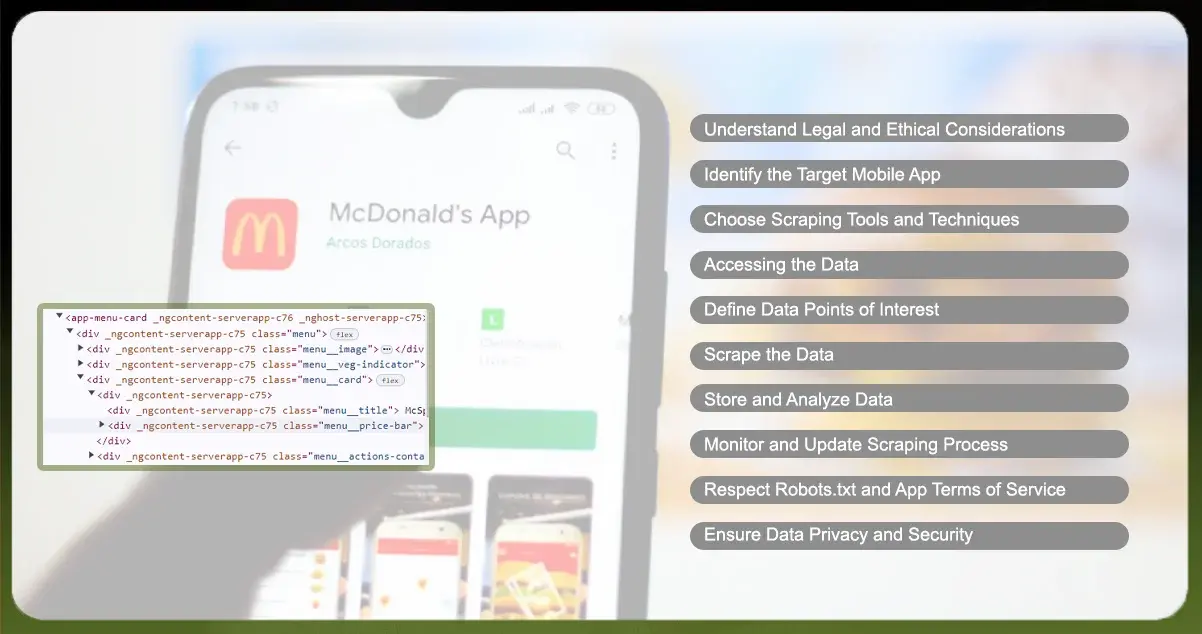
In the ever-evolving landscape of Quick Service Restaurants (QSR), leveraging data has become imperative for staying competitive and meeting customer expectations. One potent avenue for gathering valuable insights is through mobile app scraping. This process involves extracting data from QSR mobile applications to glean actionable intelligence on consumer behavior, market trends, and competitor strategies. Across Europe and the America, QSR brands are harnessing the power of Mobile App Scraping QSR Brands Across Europe And The America to fine-tune their operations, enhance customer experiences, and drive revenue growth..
Through scraping, QSR brands can analyze user demographics, ordering patterns, and feedback, enabling them to tailor menu offerings, pricing strategies, and marketing campaigns to meet the diverse preferences of their clientele. Furthermore, by monitoring competitor apps, QSR brands can benchmark their performance and identify opportunities for differentiation. Ultimately, mobile app scraping a cornerstone for data-driven decision-making, empowering QSR brands to thrive in a dynamic and competitive marketplace.
Here are six distinct points detailing how QSR brands benefit from scraped mobile app data:
Customer Behavior Analysis: Scraped mobile app data offers QSR brands deep insights into customer behavior, including ordering habits, preferred menu items, and peak ordering times. It allows brands to tailor their offerings and promotions to meet specific customer preferences, ultimately enhancing customer satisfaction and loyalty.
Menu Optimization: By analyzing data on menu item popularity and customer feedback from mobile apps using mobile app data scraping services, QSR brands can optimize their menu offerings. They can identify underperforming items, introduce new offerings based on consumer demand, and adjust pricing strategies to maximize profitability.
Competitor Benchmarking: Scraped data from competitor apps enables QSR brands to conduct thorough benchmarking analysis. Brands can compare their performance metrics, such as order volume and customer ratings, against competitors to identify areas for improvement and opportunities for differentiation.
Operational Efficiency: Mobile app data scraping provides QSR brands with insights into operational efficiency. By analyzing order fulfillment times, customer wait times, and peak hours, brands can optimize staffing levels, streamline operations, and improve service quality to enhance customer experience.
Targeted Marketing Campaigns: With scraped mobile app data access, QSR brands can create highly targeted marketing campaigns. By segmenting customers based on demographic information and ordering preferences, brands can deliver personalized promotions and offers, driving customer engagement and increasing sales.
Customer Feedback and Service Improvement: Monitoring customer reviews and feedback using a mobile app data scraper allows QSR brands to identify areas for service improvement in real-time. Brands can promptly address customer concerns, improve service quality, and build stronger relationships, leading to increased customer satisfaction and loyalty.
The following list of data is available from Mobile app scraping.
Collecting and analyzing these diverse datasets empower QSR brands to make data-driven decisions, enhance customer experiences, and drive business growth.

Scraping mobile app data for a QSR (Quick Service Restaurant) brand involves several steps and considerations. Here's a general guide on how to scrape mobile app data for a QSR brand:
Following these steps and best practices, you can scrape mobile app data effectively and ethically for your QSR brand, gaining valuable insights to inform your business decisions and strategies.
Conclusion: Scraping mobile app data for QSR brands across diverse markets in Europe and the America offers many opportunities for strategic growth and enhanced customer experiences. By harnessing insights derived from scraped data, QSR brands can tailor their offerings, optimize operations, and stay ahead of the competition. However, navigating legal and ethical considerations is crucial, as well as ensuring compliance with data privacy regulations and respecting app usage policies. With a well-executed scraping strategy and a commitment to responsible data usage, QSR brands can unlock valuable insights to drive innovation, improve efficiency, and foster long-term success in the dynamic landscape of the QSR industry.
Discover unparalleled web scraping service or mobile app data scraping offered by iWeb Data Scraping. Our expert team specializes in diverse data sets, including retail store locations data scraping and more. Reach out to us today to explore how we can tailor our services to meet your project requirements, ensuring optimal efficiency and reliability for your data needs.